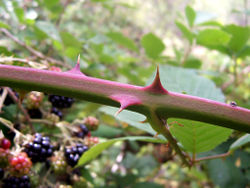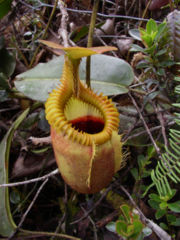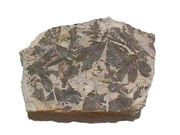Plant
2007 Schools Wikipedia Selection. Related subjects: General Biology
| iPlantae |
||||
|---|---|---|---|---|
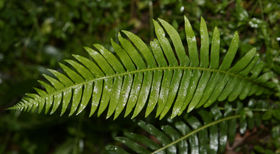 Fern frond
|
||||
| Scientific classification | ||||
|
||||
|
|
||||
|
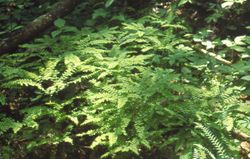
Plants are a major group of living things including familiar organisms such as trees, flowers, herbs, ferns, and mosses. About 350,000 species of plants, defined as seed plants, bryophytes, ferns and fern allies, have been estimated to exist. As of 2004, some 287,655 species had been identified, of which 258,650 are flowering and 15,000 bryophytes. Plants are mostly autotrophs, organisms that obtain energy from sunlight or organisms that make their own food. Most plants carry out a process called photosynthesis, which occurs in the chloroplasts of plants.
Classification
Aristotle divided all living things between plants, which generally do not move, and animals. In Linnaeus' system, these became the Kingdoms Vegetabilia (later Plantae) and Animalia. Since then, it has become clear that the Plantae as originally defined included several unrelated groups, and the fungi and several groups of algae were removed to new kingdoms. However, these are still often considered plants in many contexts. Indeed, any attempt to match "plant" with a single taxon is doomed to fail, because plant is a vaguely defined concept unrelated to the presumed phylogenic concepts on which modern taxonomy is based.
When the name Plantae is applied to a specific taxon, it is usually one of three groups, each more inclusive than the last. From smallest to largest these are
- Land plants (also known as Embryophyta) - see below
- Green plants (also known as Viridiplantae or Chlorobionta) comprising Embryophytes and and green algae. Essentially the subject of this article.
- Primoplantae (also known as Plantae sensu lato, Plastida, or Archaeplastida) comprises green plants, red algae and glaucophyte algae. The broadest plant clade, this comprises the eukaryotes that acquired their chloroplasts directly by engulfing bacteria.
Informally, other creatures that carry out photosynthesis are called plants as well, but they do not constitute a formal taxon.
Embryophytes
Most familiar are the multicellular land plants, called embryophytes. They include the vascular plants, plants with full systems of leaves, stems, and roots. They also include a few of their close relatives, often called bryophytes, of which mosses and liverworts are the most common.
All of these plants have eukaryotic cells with cell walls composed of cellulose, and most obtain their energy through photosynthesis, using light and carbon dioxide to synthesize food. About three hundred plant species do not photosynthesize but are parasites on other species of photosynthetic plants. Plants are distinguished from green algae, which represent a mode of photosynthetic life similar to the kind modern plants are believed to have evolved from, by having specialized reproductive organs protected by non-reproductive tissues.
Bryophytes first appeared during the early Palaeozoic. They can only survive where moisture is available for significant periods, although some species are desiccation tolerant. Most species of bryophyte remain small throughout their life-cycle. This involves an alternation between two generations: a haploid stage, called the gametophyte, and a diploid stage, called the sporophyte. The sporophyte is short-lived and remains dependent on its parent gametophyte.
Vascular plants first appeared during the Silurian period, and by the Devonian had diversified and spread into many different land environments. They have a number of adaptations that allowed them to overcome the limitations of the bryophytes. These include a cuticle resistant to desiccation, and vascular tissues which transport water throughout the organism. In most the sporophyte acts as a separate individual, while the gametophyte remains small.
The first primitive seed plants, Pteridosperms (seed ferns) and Cordaites, both groups now extinct, appeared in the late Devonian and diversified through the Carboniferous, with further evolution through the Permian and Triassic periods. In these the gametophyte stage is completely reduced, and the sporophyte begins life inside an enclosure called a seed, which develops while on the parent plant, and with fertilisation by means of pollen grains. Whereas other vascular plants, such as ferns, reproduce by means of spores and so need moisture to develop, some seed plants can survive and reproduce in extremely arid conditions.
Early seed plants are referred to as gymnosperms (naked seeds), as the seed embryo is not enclosed in a protective structure at pollination, with the pollen landing directly on the embryo. Four surviving groups remain widespread now, particularly the conifers, which are dominant trees in several biomes. The angiosperms, comprising the flowering plants, were the last major group of plants to appear, emerging from within the gymnosperms during the Jurassic and diversifying rapidly during the Cretaceous. These differ in that the seed embryo(angiosperm) is enclosed, so the pollen has to grow a tube to penetrate the protective seed coat; they are the predominant group of flora in most biomes today.
Algae and fungi
The algae comprise several different groups of organisms that produce energy through photosynthesis. However, they are not classified within the Kingdom Plantae but mostly in the Kingdom Protista. Most conspicuous are the seaweeds, multicellular algae that may roughly resemble terrestrial plants, but are classified among the green, red, and brown algae. These and other algal groups also include various single-celled organisms.
The embryophytes developed from green algae; the two groups are collectively referred to as the green plants or Viridiplantae. The Kingdom Plantae is often taken to mean this monophyletic grouping. With a few exceptions among the green algae, all such forms have cell walls containing cellulose and chloroplasts containing chlorophylls a and b, and store food in the form of starch. They undergo closed mitosis without centrioles, and typically have mitochondria with flat cristae.
The chloroplasts of green plants are surrounded by two membranes, suggesting they originated directly from endosymbiotic cyanobacteria. The same is true of the red algae, and the two groups are generally believed to have a common origin (see Archaeplastida). In contrast, most other algae have chloroplasts with three or four membranes. They are not close relatives of the green plants, presumably in origin acquiring chloroplasts separately from ingested or symbiotic green and red algae.
Unlike embryophytes and algae, fungi are not photosynthetic, but are saprotrophs: obtaining food by breaking down and absorbing surrounding materials. Most fungi are formed by microscopic structures called hyphae, which may or may not be divided into cells but contain eukaryotic nuclei. Fruiting bodies, of which mushrooms are most familiar, are the reproductive structures of fungi. They are not related to any of the photosynthetic groups, but are close relatives of animals. Therefore, the fungi are in a kingdom of their own.
Importance
The study of plant uses by people is termed economic botany or ethnobotany. They are often used as synonyms but some consider economic botany to focus mainly on uses of modern cultivated plants, while ethnobotany studies uses of indigenous plants by native peoples. Human cultivation of plants is part of agriculture, which is the basis of human civilization. Plant agriculture is subdivided into agronomy, horticulture and forestry.
Food
Virtually all human nutrition depends on land plants, directly or indirectly. The animals some people eat are mainly herbivores. Much of human nutrition depends on cereals, especially corn, wheat and rice or other staple crops such as potato, cassava, and legumes. Other plants that are eaten include fruits, vegetables, nuts, herbs, spices and edible flowers. Beverages from plants include coffee, tea, wine, beer and alcohol. Sugar is obtained mainly from sugar cane and sugar beet. Cooking oils and margarine come from corn, soybean, canola, safflower, sunflower, olive and others. Food additives include gum arabic, guar gum, locust bean gum, starch and pectin.
Nonfood products
Wood is used for buildings, furniture, paper, cardboard, musical instruments and sports equipment. Cloth is often made from cotton, flax or synthetic fibers derived from cellulose, such as rayon and acetate. Renewable fuels from plants include firewood, peat and many other biofuels. Coal and petroleum are fossil fuels derived from plants. Medicines derived from plants include aspirin, taxol, morphine, quinine, reserpine, colchicine, digitalis and vincristine. There are hundreds of herbal supplements such as ginkgo, Echinacea, feverfew, and Saint John's wort. Pesticides derived from plants include nicotine, rotenone, strychnine and pyrethrins. Illegal drugs from plants include opium, cocaine and marijuana. Poisons from plants include ricin, hemlock and curare. Plants are the source of many natural products such as fibers, essential oils, dyes, pigments, waxes, tannins, latex, gums, resins, alkaloids, amber and cork. Products derived from plants include soaps, paints, shampoos, perfumes, cosmetics, turpentine, rubber, varnish, lubricants, linoleum, plastics, inks, chewing gum and hemp rope. Plants are also a primary source of basic chemicals for the industrial synthesis of a vast array of organic chemicals.
Aesthetic uses
Thousands of plant species are cultivated to beautify the human environment as well as to provide shade, modify temperatures, reduce windspeed, abate noise, provide privacy and prevent soil erosion. People use cut flowers, dried flowers and house plants indoors. Outdoors, they use lawngrasses, shade trees, ornamental trees, shrubs, vines, herbaceous perennials and bedding plants. Images of plants are often used in art, architecture, humor, language and photography and on textiles, money, stamps, flags and coats of arms. Living plant art forms include topiary, bonsai, ikebana and espalier. Ornamental plants have sometimes changed the course of history, as in tulipomania. Plants are the basis of a multi-billion dollar per year tourism industry which includes travel to arboretums, botanical gardens, historic gardens, national parks, tulip festivals, rainforests, forests with colorful autumn leaves and the National Cherry Blossom Festival. Venus flytrap, sensitive plant and resurrection plant are examples of plants sold as novelties.
Scientific and cultural uses
Tree rings are an important method of dating in archeology and serve as a record of past climates. Basic biological research has often been done with plants, such as the pea plants used to derive Gregor Mendel's laws of genetics. Space stations or space colonies may one day rely on plants for life support. Plants are used as national and state emblems, including state trees and state flowers. Ancient trees are revered and many are famous. Numerous world records are held by plants. Plants are often used as memorials, gifts and to mark special occasions such as births, deaths, weddings and holidays. Plants figure prominently in mythology, religion and literature. The field of ethnobotany studies plant use by indigenous cultures which helps to conserve endangered species as well as discover new medicinal plants. Gardening is the most popular leisure activity in the U.S. Working with plants or horticulture therapy is beneficial for rehabilitating people with disabilities.
Negative effects
Weeds are plants that grow where people do not want them to grow. They cause billions of dollars in crop losses annually. People have spread plants far beyond their native ranges. Many introduced plants are invasive in areas where they are not native. Invasive plants are often major weeds. They also crowd out native species and damage or destroy existing ecosystems. Many people suffer from hay fever caused by pollen allergies. A wide variety of plants are poisonous. Several plants cause skin irritations when touched, especially poison ivy. Use of tobacco products are a major cause of several diseases such as lung cancer and heart disease.
Growth
It is a common misconception that most of the solid material in a plant is taken from the soil, when in fact almost all of it is actually taken from the atmosphere. Through a process known as photosynthesis, plants use the energy in sunlight to convert carbon dioxide from the atmosphere into simple sugars. These sugars are then used as building blocks and form the main structural component of the plant. Plants rely on soil primarily for water (in quantitative terms), but also obtain nitrogen, phosphorus and other crucial elemental nutrients. For the majority of plants to grow successfully they also require oxygen in the atmosphere (for respiration in the dark) and oxygen around their roots. A few specialised vascular plants, such as Mangroves, can however grow with their roots in anoxic conditions.
Simple plants like algae may have short life spans as individuals, but their populations are commonly seasonal. Other plants may be organized according to their seasonal growth pattern:
- Annual: live and reproduce within one growing season.
- Biennial: live for two growing seasons; usually reproduce in second year.
- Perennial: live for many growing seasons; continue to reproduce once mature.
Among the vascular plants, perennials include both evergreens that keep their leaves the entire year, and deciduous plants which lose their leaves for some part. In temperate and boreal climates, they generally lose their leaves during the winter; many tropical plants lose their leaves during the dry season.
The growth rate of plants is extremely variable. Some mosses grow less than 0.001 mm/h, while most trees grow 0.025-0.250 mm/h. Some climbing species, such as kudzu, which do not need to produce thick supportive tissue, may grow up to 12.5 mm/h.
Plants protect themselves from frost and dehydration stress with antifreeze proteins, heat-shock proteins and sugars ( sucrose is common). LEA (Late Embryogenesis Abundant) protein expression is induced by stresses and protects other proteins from aggregation as a result of desiccation and freezing.
Ecological relationships
The photosynthesis conducted by land plants and algae is the ultimate source of energy and organic material in nearly all ecosystems. Photosynthesis radically changed the composition of the early Earth's atmosphere, which as a result is now 21% oxygen. Animals and most other organisms are aerobic, relying on oxygen; those that do not are confined to relatively rare anaerobic environments. Plants are the primary producers in most terrestrial ecosystems and form the basis of the food web in those ecosystems. Many animals rely on plants for shelter as well as oxygen and food.
Land plants are key components of the water cycle and several other biogeochemical cycles. Some plants have coevolved with nitrogen fixing bacteria, making plants an important part of the nitrogen cycle. Plant roots play an essential role in soil development and prevention of soil erosion. The Earth's biomes are named for the type of vegetation because plants are the dominant organisms in biomes.
Numerous animals have coevolved with plants. Many animals pollinate flowers in exchange for food in the form of pollen or nectar. Many animals disperse seeds, often by eating fruit and passing the seeds in their feces. Myrmecophytes are plants that have coevolved with ants. The plant provides a home, and sometimes food, for the ants. In exchange, the ants defend the plant from herbivores and sometimes competing plants. Ant wastes provide organic fertilizer.
The majority of plant species have various kinds of fungi associated with their root systems in a kind of mutualistic symbiosis known as mycorrhiza. The fungi help the plants gain water and mineral nutrients from the soil, while the plant gives the fungi carbohydrates manufactured in photosynthesis. Some plants serve as homes for endophytic fungi that protect the plant from herbivores by producing toxins. The fungal endophyte, Neotyphodium coenophialum, in tall fescue (Festuca arundinacea) does tremendous economic damage to the cattle industry in the U.S.
Various forms of parasitism are also fairly common among plants, from the semi-parasitic mistletoe that merely takes some nutrients from its host, but still has photosynthetic leaves, to the fully parasitic broomrape and toothwort that acquire all their nutrients through connections to the roots of other plants, so have no chlorophyll. Some plants, known as myco-heterotrophs, parasitize mycorrhizal fungi, and hence act as epiparasites on other plants.
Many plants are epiphytes, meaning they grow on other plants, usually trees, without parasitizing them. Epiphytes may indirectly harm their host plant by intercepting mineral nutrients and light that the host would otherwise receive. The weight of large numbers of epiphytes may break tree limbs. Many orchids, bromeliads, ferns and mosses often grow as epiphytes. Bromeliad epiphytes accumulate water in leaf axils to form phytotelmata, complex aquatic food webs.
A few plants are carnivorous, such as the Venus Flytrap and sundew. They trap small animals and digest them to obtain mineral nutrients, especially nitrogen.
Fossils
Plant fossils include roots, wood, leaves, seeds, fruit, pollen, spores, phytoliths, and amber (the fossilized resin produced by some plants). Fossil land plants are recorded in terrestrial, lacustrine, fluvial and nearshore marine sediments. Pollen, spores and algae ( dinoflagellates and acritarchs) are used for dating sedimentary rock sequences. The remains of fossil plants are not as common as fossil animals, although plant fossils are locally abundant in many regions worldwide.
Early fossils of these ancient plants show the individual cells within the plant tissue. The Devonian period also saw the evolution of what many believe to be the first modern tree, Archaeopteris. This fern-like tree combined a woody trunk with the fronds of a fern, but produced no seeds.
The Coal Measures are a major source of Palaeozoic plant fossils, with many groups of plants in existence at this time. The spoil heaps of coal mines are the best places to collect; coal itself is the remains of fossilised plants, though structural detail of the plant fossils is rarely visible in coal. In the Fossil Forest at Victoria Park in Glasgow, Scotland, the stumps of Lepidodendron trees are found in their original growth positions.
The fossilized remains of conifer and angiosperm roots, stems and branches may be locally abundant in lake and inshore sedimentary rocks from the Mesozoic and Caenozoic eras. Sequoia and its allies, magnolia, oak, and palms are often found.
Petrified wood is common in some parts of the world, and is most frequently found in arid or desert areas where it is more readily exposed by erosion. Petrified wood is often heavily silicified (the organic material replaced by silicon dioxide), and the impregnated tissue is often preserved in fine detail. Such specimens may be cut and polished using lapidary equipment. Fossil forests of petrified wood have been found in all continents.
Fossils of seed ferns such as Glossopteris are widely distributed throughout several continents of the southern hemisphere, a fact that gave support to Alfred Wegener's early ideas regarding Continental drift theory.
Internal Distribution
Nutrients from the soil are distributed to specific areas in the plant through vessels, for example to the leaves to conduct photosynthesis. Also the glucose produced during photosynthesis is distributed around the plant to give the plant energy to keep growing and seeding.
